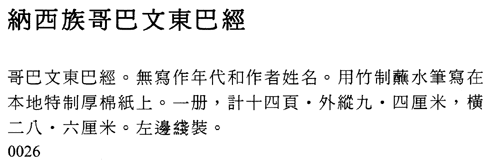 |
|
|
 |
Dongba Text of
the Naxi People in Geba Script Qing
dynasty (1644�1911), undated, ca. 18th�19th centuries Booklet
of 14 folios (including top and bottom covers), ink on paper; each folio:
approx. 9.4 x 28.6 cm Inventory number: 0026 The
Naxi people, who now number around 278,000 and have their capital at Lijiang
(at the first great bend of the Jinsha River), speak a Tibeto-Burman language
that is monosyllabic.� They possess the
only active pictographic script in the world, in addition to a phonetic script
called Geba; some texts are written in a combination of both scripts. Geba
script is drawn from three sources: Chinese characters, "indigenous"
graphs, and simplified pictographs.� The
phonetic values of Geba script are not fixed; each user (usually a dongba,
or priest) tends to prefer one set of symbols over another, and symbols can
have various phonetic values, or a phonetic value can be signified by a number
of graphs.� Not widely distributed,
writings in Geba script are found only in the southern part of Naxi territory,
in and around Lijiang and in the Judian-Weixi area. The
National Library of China's Naxi collection consists of more than 4,000
manuscripts; most of the collection was assembled in 1942 from the Lijiang
area.� This booklet is a representative
piece from the collection; it is made up of 14 stiffened folios (including the
titled and illustrated top cover as well as the blank bottom cover) made by the
Naxi from tree bark.� It is in the
standard form of a long rectangle and stitchbound along the left side.� The 12 inner folios are inscribed on both
sides, and each folio is divided into four rows of 14 or 15 Geba
"characters."� Geba and
Tibetan books have in common the shape of the manuscripts (with leaves stitched
on the left side), the reading sequence from left to right, and the fact that
both are syllabic. |
 |